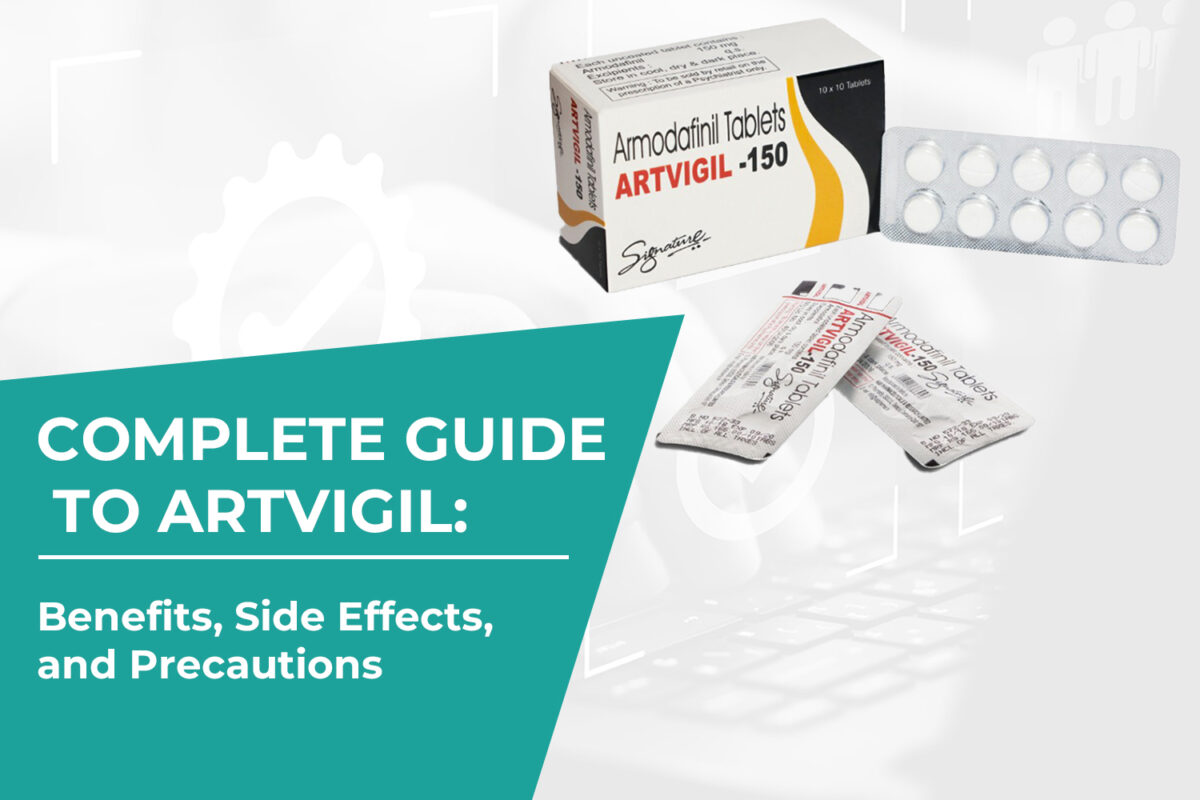What is Artvigil?
Artvigil, which contains Armodafinil, is used to treat various sleep disorders such as narcolepsy, OSA, and shift work sleep disorder. Its wakefulness-promoting characteristics facilitate the ability to stay awake and alert. Despite the temporary benefits of Artvigil in addressing these concerns, there is a lingering question regarding its long-term safety.
Artvigil possesses the capacity to impact individuals’ health for extended durations, and the increasing prevalence of its consumption underscores the need for further investigation. Based on the existing research, armodafinil seems to have minimal adverse effects when used for extended periods.
Like any medication, there is a possibility of experiencing negative effects, developing tolerance, and becoming dependent on it. Both healthcare providers and patients must carefully evaluate the advantages and risks of this medication before deciding to utilize it for an extended period.
Dosage Guidelines
- Do not take Artvigil unless a medical health practitioner instructs you to do so.
- Generally, they would recommend a dosage of one tablet, i.e., 150 mg of armodafinil a day.
- Stick to the dosage regimen and duration given by your doctor.
- If you miss a dose, skip the dose and move on to the next. Do not take a double dose to make up for it.
- Keep a fixed time for taking the tablet. Do not take it close to bedtime, as it would cause insomnia.
- Do not abruptly stop taking the medicine. Your physician will gradually reduce the dosage to stop the medication.
What are the side effects of Artvigil tablets?
Those who consume artvigil may have symptoms such as nausea, headaches, and insomnia. Possible adverse effects include nervousness, lightheadedness, xerostomia, decreased appetite, tachycardia, dorsalgia, and rash. It is imperative to remain vigilant for any significant or persistent reactions and, if needed, consult with a medical professional.
How does an Artvigil tablet work?
The primary component of Artvigil tablets, armodafinil, is a medication that is primarily used to keep people awake who have specific sleep issues. Although the precise mechanism of armodafinil’s action is unknown, it is believed to wake the brain by altering certain molecules in it.
◈ Here’s a brief explanation of how the tablet operates:
Neurotransmitter Modulation
Armodafinil, similar to Modafinil, is believed to primarily alter the levels of neurotransmitters in the brain, such as dopamine, norepinephrine, and histamine. These hormones play a crucial role in regulating a patient’s wakefulness, attentiveness, and concentration.
Dopamine Release
Armodafinil is believed to primarily enhance the release of dopamine in specific areas of the brain, such as the hypothalamus and prefrontal cortex. Dopamine is a neurotransmitter that enhances patients’ motivation, happiness, and cognitive awareness.
Histamine Stimulation
It also increases the activity of histamine, which is another neurotransmitter that helps patients stay awake and alert.
Effects on Norepinephrine
It may also raise the amount of norepinephrine in the body. Norepinephrine is a chemical that helps control alertness, focus, and attention.
Precautions & Warnings
Pregnancy and breastfeeding
It has not been proven that Artvigil is safe for women who are pregnant or who are nursing. People in these groups should talk to a doctor before starting Artvigil treatment.
Heart Health
Artvigil can raise blood pressure and heart rate (tachycardia) in people who already have heart trouble. During the Artvigil treatment, the heart should be checked on a frequent basis.
Liver Function
The liver breaks down Artvigil, so people whose liver function isn’t working well may need to change the amount they take. Before treatment, it’s a good idea to check how well the liver is working, and it should be closely watched during treatment as well.
Mental Health Conditions
Psychiatric conditions like anxiety, sadness, or psychosis may get worse when Artvigil is used. Psychiatrists should carefully watch over people who already have mental health problems.
Misusing drugs
Because Artvigil can be abused and lead to dependence, it should be given with care, especially to people who have a history of drug abuse.
Medication interactions
Taking Artvigil with some medicines, like hormonal birth control pills, cyclosporine, or some antifungal drugs, may make these medicines less effective. It is very important to let your doctors know about all the medicines you are taking so that drug reactions don’t happen as often.
Interaction
A substance called armodafinil is found in the drug Artvigil. For some drugs or substances, taking them together may make them less effective or make side effects more likely. Patients who are going to start taking Artvigil should talk to their doctors about any possible drug problems before they start treatment. Please pay close attention to the following interactions:
Hormonal Contraceptives
Artvigil might reveal liver enzymes, which might lower the effectiveness of hormonal birth control methods like pills, patches, or shots.
Cyclosporine
Studies show that Artvigil lowers the amount of cyclosporine in the blood. So, it is very important to keep an eye on the levels of cyclosporine and possibly change the dose so that the treatment for transplant patients stays effective.
Antifungal Drugs
If you take Artvigil and some antifungal drugs, like ketoconazole or itraconazole, the drugs may build up in your blood, which makes side effects more likely.
Alcohol
Taking Artvigil with alcohol could make the depressing affects on the brain and spinal cord stronger, making symptoms like sleepiness, dizziness, and poor brain function worse.

